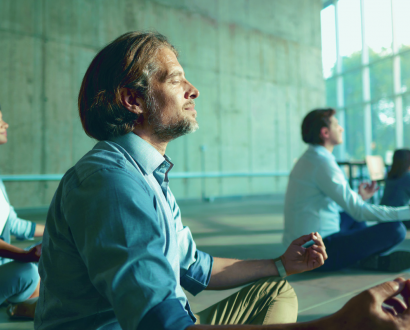Executives are embracing the powerful benefits of wellness tourism

The business of the tourism industry has seen a sizable post-COVID-19-pandemic departure from traditional travel norms. Travelers are embracing more culture; they demand sustainability and there’s an increased desire for real and authentic experiences. In addition to this, one of the greatest developments has been the significant shift towards wellness tourism. As a trend, we are seeing a huge uptake from business owners and C-level executives who are recognizing the importance of prioritizing physical and mental wellbeing.
To further corroborate this shifting trend, figures released by the Global Wellness Institute reveal that the global wellness tourism market is expected to soar to US$1.3 trillion by 2025. This is a huge increase from the market size in 2019, which was then valued at US$720 billion.
The pandemic’s transformative impact
Spurred on by the pandemic, social media amplification and increased societal awareness, 73 percent of travelers are planning a vacation around improving their physical and emotional health, according to American Express Travel’s ‘2023 Global Travel Trends Report’.
During this time, many of us were encouraged to reassess our life and habits. Our health was in the spotlight, and self-care was paramount. For most, especially business owners and C-level executives, it was a time to reflect and set short-term goals for the time spent isolated or in lockdown, with cities like Melbourne enforcing restrictions for nearly six months.
For many, the positive impact of these new habits lasted long after the pandemic restrictions – they turned into longer-term life-changing strategies that have been adopted across all aspects of their life. This includes the way that these executives travel and where they spend their leisure time.

Tending to the challenges of executives
Busy professionals, especially those at the top, often face high levels of stress and pressure, whether it is making decisions involving millions of dollars in transactions to changing the growth trajectory of the company. These life-altering efforts can take a toll on their physical and mental wellbeing. Maintaining good health and fitness and avoiding burnout is especially crucial for them to perform their best in these demanding roles.
Social media platforms like TikTok and Instagram, and the growing popularity of leaders promoting wellness, have also spurred on the allure of self-development, mental health, positive mindset, healthy living and wellbeing breaks. As a result, traveling for physical, emotional and spiritual development has changed the way we define what a wellness break is today.
While playing a major role in the promotion of wellness tourism, social media apps have also increased the awareness of wellness travel and tourism. Our reliance on social media during the pandemic, as well as increasing societal awareness of the impact of social and digital technology on our mental health, has led to more and more guests opting to ‘check-in and log out’.
Maintaining good health and fitness and avoiding burnout is especially crucial for them to perform their best in these demanding roles.
A wellness retreat creates an opportunity to escape and engage in activities that reduce stress, promote relaxation and restore balance, allowing executives to disconnect from work and prioritize their health and personal development. They may gain new insights, learn coping strategies for managing stress and challenges, and develop habits that promote long-term wellbeing and success.
As conversations around the impact that female sexual health issues and menopause have and on working women start to open up – employers have become more flexible and wellness resorts are now catering more to women who plan their vacations around key stages in life. Menopause retreats, babymoons, later-life wellbeing and so on are seeing a surge in popularity, more so with women in high-powered, high-stress jobs.
Busy business owners and CEOs prefer to partake in wellness when they’re relaxed and rejuvenated, rather than rushed and stressed from the hustle, bustle and responsibility of daily life. These travelers recognize that to truly reap the holistic benefits of time invested in wellness, practice should take place at a more relaxed and convenient time – another factor contributing to the rise of wellness tourism.
Wellness retreat myths
Traditionally, wellness breaks consisted of spa time with relaxing treatments, ample pamper time, green smoothies and morning workouts in a traditional gym. Today the concept of a wellness break has taken on a whole new meaning. As executive workloads get heavier, the benefits of the mind–body connection are needed now more than ever, and the industry offers an abundance of innovating treatments, practices and experiences that aim to promote this holistic interconnectedness.
From medically infused treatments and self-development classes, to sound therapy, multi-generational retreats and more, the demand for more elevated wellness experiences is on the rise. Guests are more sophisticated with their expectations for first-class wellness, expecting deep personalization and an integration of both traditional and scientific practices.
As the medical industry continues to develop, treatments, such as genomic testing allow practitioners to map out completely tailored wellness itineraries based on a person’s unique DNA. This is particularly appealing for those executives who want to have an early understanding of pre-existing issues and take preventive measures, including scaling back, hiring personnel and making lifestyle changes to balance busy workloads more efficiently.
While wellness tourism grows, traditional travelers seek a healthier approach to their vacation experience. Whether opting for more fitness and outdoor based activities – which follows on from the experiential travel trend – to researching greener culinary options at the destination, wellness tourism is widespread.
Families are seeking out opportunities for multi-generational units to reconnect on a deeper level – and often these are wellness-focused.
Factors ranging from the aftermath of the pandemic to the influence of social media are the main factors drivers of growth for the industry. It’s much more than a wellness trend; it reflects a profound shift and a deeper societal understanding of emotional and physical health.
Another very interesting development has been an upward trend in the demand for intergenerational group travel. Families are seeking out opportunities for multi-generational units to reconnect on a deeper level – and often these are wellness-focused. There is even a term for this – SkipGen – when grandparents go on vacations with their grandchildren, while the parents stay behind.
As we further navigate an era of self-care and mental health, we can expect further growth and innovation in the sector. It will be fueled by a desire for more authentic and culturally connected encounters, greater personalization of treatments and opportunities for a deeper connection to oneself.
The trajectory of wellness tourism promotes a fundamental move towards holistic health and wellness travel, and we’re excited about the developments that lie ahead and their impact on the long-term wellbeing of our guests.